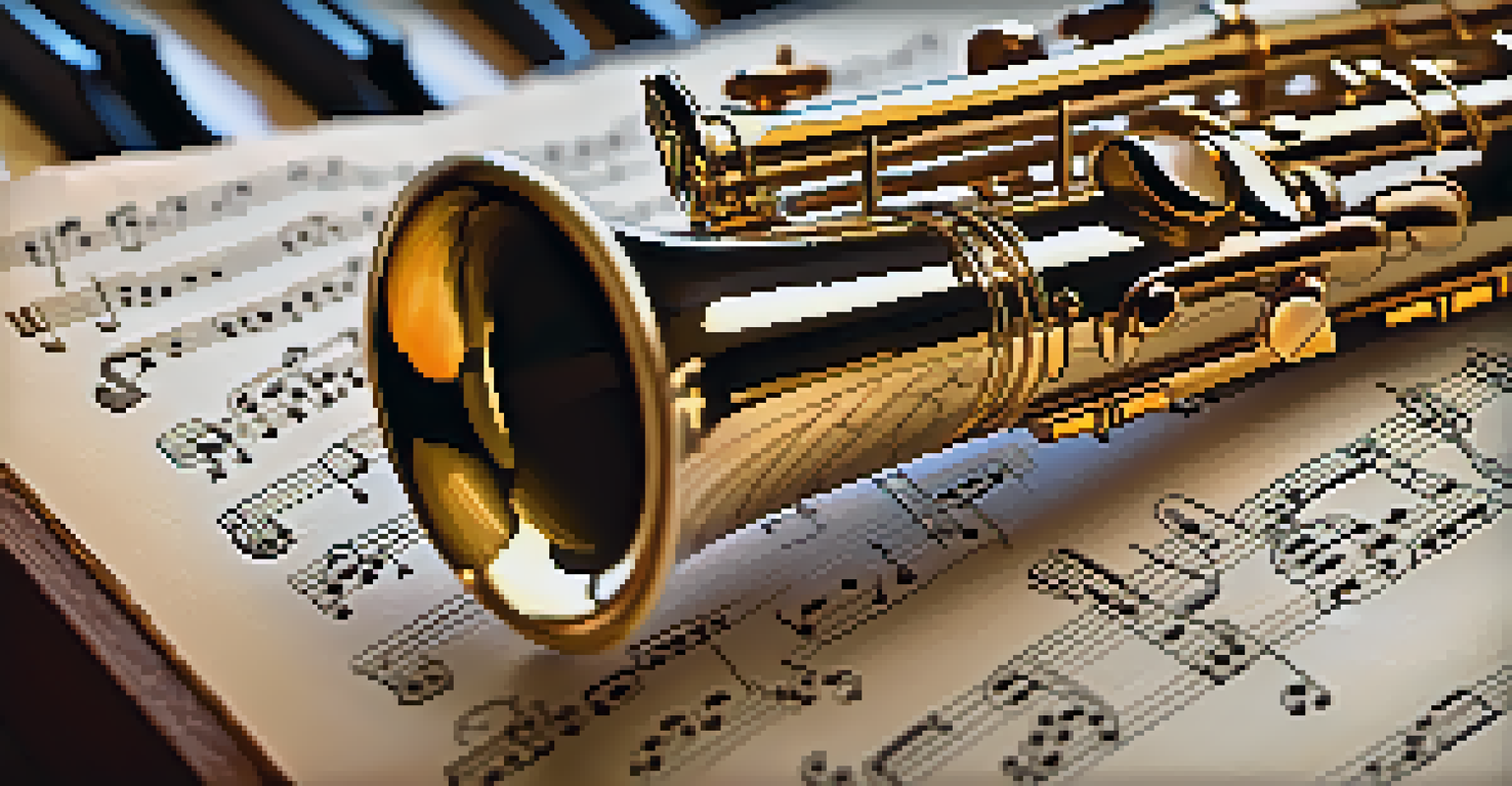Improving Phrasing Techniques for Woodwind Instruments

Understanding the Importance of Phrasing in Music
Phrasing is the art of shaping a musical line, much like how a poet crafts a sentence. For woodwind players, mastering phrasing is essential as it conveys emotion and meaning in a performance. Think of it as painting a picture with sound, where each phrase adds depth and color to the overall composition.
Music is the shorthand of emotion.
Without proper phrasing, even the most technically proficient performance can fall flat. Musicians need to breathe life into their notes, creating a narrative that captivates the audience. Just like a storyteller pauses for effect, woodwind players must learn where to emphasize or soften their sound to enhance the musical narrative.
Ultimately, good phrasing transforms a simple melody into an expressive journey. By focusing on phrasing techniques, woodwind players can develop a unique voice that resonates with listeners, making their performances memorable.
Breathing Techniques for Better Phrasing Control
Breath control is a fundamental aspect of playing woodwind instruments, directly affecting phrasing. Proper breathing techniques allow musicians to sustain notes longer and articulate phrases more effectively. For instance, using diaphragmatic breathing can help musicians maintain a steady air supply, leading to more controlled and expressive playing.

Incorporating breathing exercises into practice routines can strengthen this essential skill. Players can practice inhaling deeply before playing a phrase and exhaling slowly while sustaining a note. This method not only improves lung capacity but also enhances the overall musicality of the performance.
Mastering Phrasing Enhances Emotion
Effective phrasing allows woodwind players to convey deeper emotional narratives in their performances.
Remember, breath is the life force of music. By mastering breathing techniques, woodwind players can elevate their phrasing, creating a more dynamic listening experience for their audience.
Using Dynamics to Enhance Musical Phrasing
Dynamics refer to the variations in loudness and intensity within a musical piece, playing a crucial role in phrasing. For woodwind players, understanding how to manipulate dynamics can add layers of expression to their performance. Imagine a gentle breeze gradually becoming a strong wind; this is how dynamics can shape the emotional landscape of a phrase.
The beautiful thing about learning is that no one can take it away from you.
Practicing scales and pieces at different dynamic levels can help players internalize the importance of volume changes. For example, starting softly and gradually increasing volume before tapering off can create a powerful effect that captures the listener's attention. This dynamic contrast is key in making phrases stand out.
Moreover, incorporating dynamics allows musicians to communicate more effectively with their audience. By using dynamic changes wisely, woodwind players can evoke feelings and reactions that resonate long after the performance ends.
Articulations: The Building Blocks of Phrasing
Articulation refers to how notes are played or sung, and it greatly influences phrasing. For woodwind players, mastering different articulations—such as staccato, legato, and accents—can help create varied musical expressions. Think of articulation as the punctuation in a sentence; it dictates how the message is delivered.
Incorporating various articulation techniques into practice can enhance phrasing significantly. For instance, alternating between staccato (short, detached notes) and legato (smooth, connected notes) can make a phrase more engaging. This variety not only keeps the audience captivated but also showcases the musician's versatility.
Breath Control is Essential for Musicians
Proper breathing techniques enable woodwind players to sustain notes and articulate phrases more expressively.
Ultimately, articulation adds texture to phrasing. By experimenting with different styles, woodwind players can discover their unique sound, making their musical storytelling even more compelling.
The Role of Tempo in Shaping Phrasing
Tempo, or the speed at which a piece is played, is another critical factor in phrasing. Different tempos can drastically change the feel and impact of a musical phrase. For example, a slow tempo can evoke a sense of nostalgia, while a fast tempo can create excitement and urgency, much like the difference between a leisurely stroll and a sprint.
Woodwind players should practice pieces at varying tempos to understand how it influences their phrasing. Slowing down allows for greater attention to detail, enabling musicians to focus on dynamics and articulation. Conversely, playing at a faster tempo helps develop agility and precision, essential for maintaining phrasing integrity.
By mastering tempo changes, woodwind players can enrich their phrasing. This flexibility allows them to adapt their performance to different musical contexts, ensuring their expression remains relevant and impactful.
Listening and Imitation: Learning From the Masters
One of the most effective ways to improve phrasing is through listening. By studying recordings of accomplished woodwind players, musicians can gain insights into various phrasing techniques. This process of imitation allows players to absorb different styles and approaches, enriching their own musical vocabulary.
Listening actively involves paying attention to how other musicians shape their phrases, including their use of dynamics, articulation, and tempo. Once they identify techniques they admire, players can practice incorporating these elements into their performances. This not only fosters growth but also encourages creativity.
Dynamic Variations Shape Musical Impact
Manipulating dynamics through variations in loudness enriches phrasing, creating a more engaging listening experience.
Ultimately, the art of phrasing is a continuous journey of learning and exploration. By immersing themselves in the music of others, woodwind players can enhance their phrasing skills and develop a deeper appreciation for the art of performance.
Regular Practice and Reflection for Continuous Improvement
Improving phrasing techniques requires regular practice and self-reflection. Woodwind players should set aside dedicated time to focus solely on phrasing, experimenting with different techniques and styles. This commitment to practice not only hones their skills but also builds confidence in their musical expression.
Recording oneself during practice sessions can provide valuable feedback. Listening to recordings allows musicians to identify areas for improvement and track their progress over time. This reflective practice encourages growth, helping players understand what works and what doesn’t in their phrasing.

Over time, consistent practice leads to greater mastery of phrasing techniques. By committing to this process, woodwind players can transform their performances, creating music that resonates deeply with audiences.